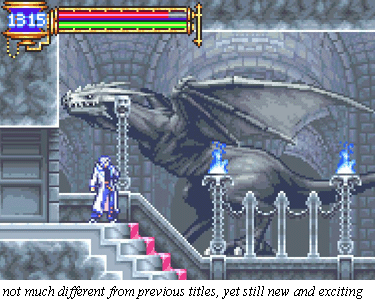Even though Aria of Sorrow is the third Castlevania for the GBA in almost as many years, it does not suffer from any of the blemishes that most rapid-fire sequels have suffered in the past—say, Mega Man, or Tomb Raider. True, there’s not much here that is entirely different from previous Castlevanias, yet somehow AoS feels fresh and exciting.
If you haven’t played it or any of its predecessors, think of the SNES classic Super Metroid nicely blended with the Castlevanias of yore, and you’ll get the idea of how AoS plays out. With a huge castle to explore, a multitude of weapons and power-ups to collect, and plenty of enemies to defeat along the way, Castlevania: Aria of Sorrow is definitely a testament to Konami’s prowess in developing slick action titles.
The story feels a little worn and hackneyed, but then again, you don’t play a Game Boy game for its story—especially not a Game Boy Castlevania game. In the year 2035, our hero, Soma Cruz, is visiting a shrine in Japan during the first solar eclipse of the 21st century. Okay, so here’s where it gets a little strange. Suddenly, Soma is rendered unconscious and wakes up in, get this, Dracula’s castle INSIDE THE SOLAR ECLIPSE! Now, I have no idea how you can have a castle inside a verb, but I suppose that’s not for me to question.
Once inside, Soma discovers that he has the ability to gain the powers of the monsters that he kills, which brings us to our first cool feature of AoS: the soul system. Basically, if you kill enough monsters, some of them will give you their “soul,” which grants various powers in three categories: Magic, Summon/Transformation, and Attribute. The first category is pretty much self-explanatory: a magic soul grants powers such as the ability to shoot lightning or throw magic spears. These spells use magic points that can be restored using potions, but also recover over time.
Summon/Transformation souls let you summon assorted familiars, like a giant sword who slices nearby enemies, and transformation types morph your character into various demons and other nasties for limited amounts of time. Once collected, Attribute souls boost various stats such as attack power, defense or luck. These effects last as long as you have the particular soul equipped. Experimenting with the near-limitless combination of souls lets you find a combination that works well for you, so try them all out as soon as you collect them.

Almost every room in Dracula’s castle has an assortment of enemies to dispose of using either the aforementioned souls, or numerous swords, spears, and other gothic weapons. Like souls, weapons are collected from fallen enemies, and some special weapons are hidden throughout the castle. Each weapon looks different, and many have attributes or their own, such as a poisonous effect, or a fire element. Sadly, later in the game when you find the really powerful weapons, there becomes less and less of a need to switch between weapons, and most of the magic will become less powerful then a swipe of your sword.
Along your journey through the castle, you come across different power-ups that will gain you access to powers such as a back-dash, double-jump, and other hyphenated ballyhoo. Gaining these power-ups usually grants you access to new parts of the castle, or to one of the several bosses that populate the castle. Controlling Soma is a breeze. The platform jumps are rarely a problem and are usually very forgiving. The response time of the weapons never gave me a problem fighting enemies, but the mapping of magic spells caused some trouble. A note to developers: It is not a good idea to have the difference between casting a spell and using your sword be a 90° d-pad separation. I wasted numerous magic points because of misfired spells.
Graphically, this game stands up pretty well against other GBA titles. The enemies look detailed and original, although some are just repeats of other enemies with the color palate swapped, Mortal Kombat-style. The castle itself looks very nice indeed with rich gothic ambience giving that creepy, haunted house kind of mood. Although the GBA’s speakers do it no justice, the music is quite original and fits the mood very well. Play the game with a good pair of headphones, you’ll thank yourself.
Overall, I found Aria of Sorrow to be an entirely entertaining experience, and a long-lasting one as far as handheld action games go. Clearing all 100% of the castle will take quite some time. If you are fond of previous Castlevania games, this should be right up your alley. Pay no attention to the goofy story; it’s not important, and skipping all the dialogue will still leave you with a very good action/platforming game. Finishing the game opens up a boss battling mode where you can earn special weapons by defeating the game’s bosses as quickly as possible, and the weapons can be used in the main game as well. By now this game is probably being sold at a discount price, and you’d do well to pick it up.
